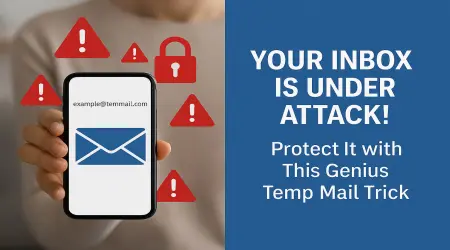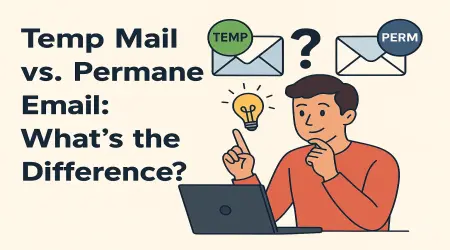
Your Credit Card Could Be at Risk — Unless You Use This One Temp Mail Hack!
A temp mail (temporary/disposable email) can stop marketing spam, reduce phishing exposure, and simplify account management — but only when used correctly. Below is a practical, step-by-step guide that protects your credit card information, lowers fraud risk, and keeps important bank communications reachable.
What is the hack — short version
Use a temp mail for sign-ups, deal sites, and third-party lead forms that often sell your contact to dozens of marketers. Reserve your permanent email for official bank communications, statements, and recovery. Combine this with virtual cards, email aliases, and strict filters to harden your inbox and reduce attack surface for phishing and data leaks.
Why your credit card is at risk (and how temp mail helps)
Every time you give your primary email to a comparison site, cashback service, or retailer, that address can be copied, sold, or leaked. More inbox exposure means more phishing messages, more chances for credential stuffing, and a harder time spotting real fraud alerts among the noise. A temp mail reduces this exposure by keeping marketing and third-party messages off your primary account — making real alerts easier to spot and reducing the number of places your address can leak from.

Step-by-step: Implement the one temp mail hack safely
- Identify where to use it. Use a temp mail on forms that request an email for newsletters, marketing, price alerts, or pre-approval offers — especially if you expect no long-term communication.
- Never substitute identity fields. Always give true name, address, national ID/SSN and phone when a bank requires identity verification. The disposable email must not be used to misrepresent identity.
- Keep your permanent email for official banking. Use your main email for statements, tax docs, and fraud notifications. After initial marketing uses, add your permanent email in the secure account portal if required for statements.
- Use virtual cards and limited-use numbers. When applying online, prefer issuers that issue virtual cards or single-use numbers — these limit merchant access to your real card number and reduce follow-up marketing tied to purchases.
- Monitor activity and enable alerts. Turn on SMS or push notifications for transactions and set low thresholds for alerts. If a suspicious charge appears, you’ll see it even if marketing still lands in another address.
- Discard, rotate, or alias. If a disposable address begins to receive spam, discard it and create a fresh one. For long-term but filterable control, consider an email alias instead — e.g., yourname+cards@gmail.com — which you can easily filter or disable.
Practical scenarios — when to use temp mail
Scenario A — Comparison sites: Comparison and lead sites often forward your email to many lenders. Use a temp mail so only the offer you accept ends up in your primary inbox when you apply directly.
Scenario B — Cashback & coupon sites: These sites can trigger merchant marketing. Use a temp mail to prevent merchant newsletters from landing in your main account.
Scenario C — One-time upgrades or promo links: If an offer only needs a one-time verification link, a temp mail is perfect — quick verification, then toss the address.
Additional defenses to combine with temp mail
- Virtual cards / tokenized numbers: Reduce merchant access to your real card.
- Two-factor authentication (2FA): Always enable 2FA for banking and email accounts; prefer hardware or app-based methods over SMS when possible.
- Strong, unique passwords: Use a password manager to avoid reuse and to store recovery info securely.
- Email filters & rules: Use filters to route confirmation emails and newsletters to a dedicated folder or to block unknown senders.
- Credit monitoring & freeze: Use free monitoring alerts and consider a credit freeze if you detect suspicious activity.
Pitfalls: when NOT to use a temp mail
- Do not use a temp mail for account recovery or long-term statements — you may lock yourself out.
- Do not use it to falsify identity or hide required legal contact details. That’s illegal and risky.
- For accounts requiring ongoing secure communication (fraud investigations, tax docs), always provide a permanent email in the bank’s secure profile.
Quick checklist before clicking submit
- Is the email field for marketing only? → OK to use a temp mail.
- Are you supplying accurate identity information elsewhere? → MUST be YES.
- Will statements or tax documents be sent here? → If YES, use your permanent email instead.
- Do you have transaction alerts enabled? → If NO, enable SMS/push alerts now.
FAQ
Q: Will using a temp mail prevent fraud?
A: It reduces exposure to phishing and marketing-based attacks, making it easier to spot legitimate fraud alerts. It’s one layer of defense — combine it with virtual cards, 2FA, and monitoring for best protection.
Q: Could a bank reject my application if I used a temp email?
A: Banks judge applications by identity and credit history. Using a disposable email for marketing fields rarely affects underwriting, but if they require a working email for statements or legal notices, they will ask for your permanent address during or after application.
Conclusion: use temp mail smartly — protect your cards, not your responsibilities
A temp mail is a practical, low-friction tool to keep your primary inbox clean and reduce your attack surface. Use it for marketing and third-party forms, keep your real email for legal and recovery channels, and combine the hack with virtual cards and strong account controls. That combination keeps your credit card safer — and your inbox sane.
Ready to try it? Create a disposable address at https://tempmail44.com and follow the checklist above before you next apply for a card or sign up for an offer.











